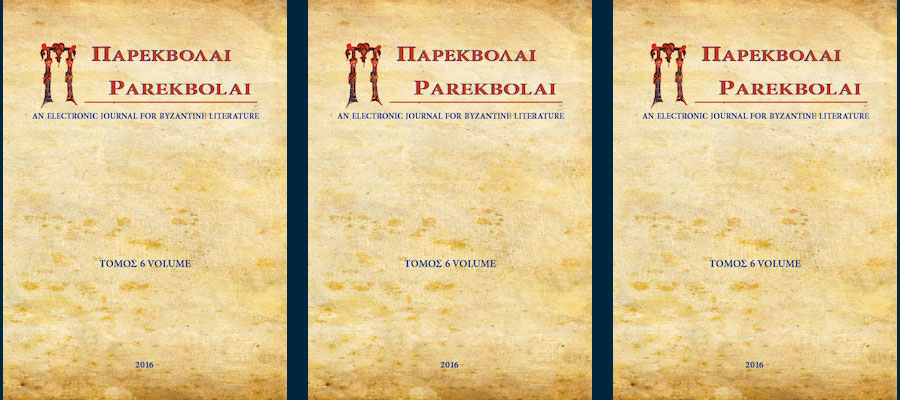Parekbolai. An Electronic Journal for Byzantine Literature 6 (2016).
CONTENTS
The Use of Monograms on Byzantine Seals in the Early Middle-Ages (6th to 9th Centuries)
Werner Seibt
The paper deals especially with monograms on Byzantine lead seals. The early form was the block monogram, a type used already in Classical times, which came into fashion in the Byzantine world in the 6th or already in the 5th century and remained important till the early 7th century. Such monograms hide normally a name, a title or an office, the Greek ones in genitive, the Latin ones in nominative or genitive. Many of them can be read in different ways. For the double using of parts of letters for other ones the well-known Latin monogram of Theoderich is explained in detail. But the “typical Byzantine monogram” became the cross monogram, with letters more or less affixed on the arms of a Greek cross. The earliest example stems from a coin of Justinus I, starting 522, quite earlier than Theodora’s monograms on capitals in the Hagia Sophia. These cruciform monograms presented in the beginning also a name, a title or an office, but in the 8th century already often a combination of them; these monograms with prosopographical information stopped in Byzantium at the end of the 8th century. On the other hand invocative monograms (like Θεοτόκε βοήθει), often with the tetragram τῷ σῷ δούλῳ in the free quarters of the monogram, started around the middle of the 7th century and can be found till the earlier 11th century. The most common ones were collected by V. Laurent – we use this system till today, though there are much more types documented. An important problem is that sometimes single letters are “hidden” in another letter, e. g. Lambda in Alpha or Delta, Epsilon in a Kappa on the left bar of a cross monogram, Sigma in Epsilon, Sigma in Kappa, Omikron in Rho, etc. In Vienna we developed a special program to solve many monograms. If we bring all the readable letters of a monogram (including the possibly additional ones) in an alphabetical order, and do the same with the letters of names, titles and offices which were used in this time, both categories can be combined without problems. Sometimes even modest combinations of letters can be interpreted in many ways – e.g. with usual and very rare names; but who could forbid someone with a rare name to produce a monogram for himself?
Zu einigen Recentiores der Epitome physica von Nikephoros Blemmydes
Stefano Valente
In this paper, some copies of Nikephoros Blemmydes’ Epitome physicaproduced in Italy between the end of the 15th and the first decades of the 16th century will be investigated according to a palaeographic, philological and cultural perspective, also in relation to the older manuscripts of this work. The first part of the article is devoted to the Barb. gr. 226 and to its copies, especially to the Laur. plut. 86,15 and to the Ambr. O 82 sup., also with some observations concerning the Laur. plut. 86,31. The second part concerns the Laur. plut. 71,8 and the Barb. gr. 246, two copies by Demetrios Damilas from the Vat. gr. 315.
Φιλολογικὲς παρατηρήσεις σὲ κείμενα τοῦ αὐτοκράτορα Ἰουλιανοῦ
Ἰωάννης Πολέμης
The new edition of the texts composed by Julian at the time of his short reign (361-363) by H.-G. Nesselrath offered us the opportunity to propose some emendations to the text of those orations.
Encomium to the Monastic Life: An Unedited Poem of Alexios Makrembolites
Dimitrios Nikou
This article presents the first critical edition of a metrical Encomium to the monastic life written by the fourteenth-century Byzantine author Alexios Makrembolites. The text is preserved in only one manuscript (Hierosolymitanus Sabbaiticus gr. 417). Makrembolites, after referring to the constant rejuvenation of the nature, wonders why people are drawn towards material goods and not to spiritual ones, distancing themselves from the immortality offered by a life close to God. After apologizing for his sinful life, he praises monastic life which he believes he should follow in order to bring an end to all his pains.
